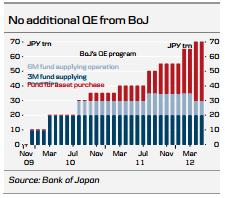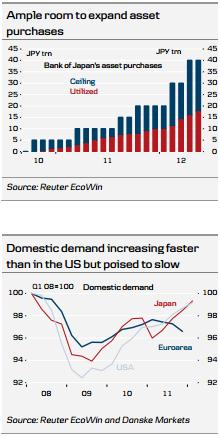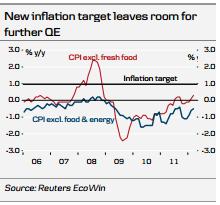Bank of Japan (BoJ) as expected did not raise the limit for its asset purchases in connection with today’s monetary meeting. While BoJ sees increasing signs of the economy shifting to a pick-up phase, it also sees increasing downside risk from the European debt crisis.
Armed with its new inflation target BoJ stays on an easing path and we expect the bank to raise the ceiling for its asset purchases further in the coming months. We also expect BoJ to extend the maturities of its bond purchases at some stage and to continue its asset purchases in 2013, when other major central banks are expected to be on hold.
Details
BoJ as expected did not announce any additional easing measures today. The limit for its asset purchase programme was left unchanged at JPY40trn and the limit for the funds supplying operation credit facility (comparable to ECB’s LTRO) was also left unchanged (at JPY30trn). Finally, the target for the O/N money market rate was left unchanged at 0.1%. All decisions were unanimous.
BoJ’s view of the Japanese economy is largely unchanged compared to the previous meeting. According to BoJ it is “increasingly evident that Japan’s economy is shifting towards a pick-up phase.” It is easy to be cynical about the Japanese economy but it has performed relatively well in recent quarters. GDP expanded 4.1% q/q AR in Q1 12 and domestic demand has expanded by more than 3% q/q AR supported by reconstruction and the reintroduction of subsidies for auto purchases. In recent quarters domestic demand in the world’s third largest economy has actually been expanding faster than in the US, see bottom chart. This underscores that the shift in inflation target and more aggressive monetary easing in 2012 has been driven more by political pressure than changes in macroeconomic fundamentals.
However, BoJ sees increasing downside risk from the international developments, particularly the European debt crisis. While the statement does not explicitly state concerns about a strong JPY, it does mention “that close attention should be paid to the developments in the financial markets.”
Assessment & Outlook
Today’s statement does not change our view that BoJ - armed with its new 1% inflation target – will stay on an easing path. We expect the bank to increase the limit for its asset purchase programme by JPY15trn in several stages during 2012 - mainly to create additional space for continuing its asset purchases in 2013. The next increase will probably be in July, but could happen as soon as the next meeting in June if stress in the financial markets continues to increase. BoJ is also likely to increase the maturities of its bond purchases at some stage (currently only maturities less than three years are eligible). Any substantial appreciation of JPY is poised to be met by more aggressive monetary easing from BoJ and possibly even renewed intervention in the FX market.
BoJ is expected to continue its asset purchases next year, when most other central banks are expected to be on hold and for that reason monetary policy should favour a weaker JPY. That said, increased risk aversion on the back of an intensifying European debt crisis and the possibility of another round of global QE might weigh on JPY in the short run.
USD/JPY has declined by about 0.4% to 79.6 on the back of BoJ’s announcement. There has been no substantial impact on the Japanese bond market from Fitch’s downgrade of Japan yesterday from AA- to A+ (10-year government bond yields up 1bp).
Disclosure
This research report has been prepared by Danske Research, a division of Danske Bank A/S ("Danske Bank").
Analyst certification
Each research analyst responsible for the content of this research report certifies that the views expressed in the research report accurately reflect the research an alyst’s personal view about the financial instruments and issuers covered by the research report. Each responsible research analyst further certifies that no part of the compensation of the research analyst was, is or will be, directly or indirectly, related to the specific recommendations expressed in the research report.
Regulation
Danske Bank is authorized and subject to regulation b y the Danish Financial Supervisory Authority and is subject to the rules and regulation of the relevant regulators in all other jurisdictions where it conducts business. Danske Bank is subject to limited regulation by the Financial Services Authority (UK). Details on the extent of the regulation by the Financial Services Authority are available from Danske Bank upon request.
The research reports of Danske Bank are prepared in accordance with the Danish Society of Financial Analysts’ rules of ethics and the recommendations of th e Danish Securities Dealers Association.
Conflicts of interest
Danske Bank has established procedures to prevent conflicts of interest and to ensure the provision of high quality research based on research objectivity and independence. These procedures are documented in the research policies of Danske Bank. E mployees within the Danske Bank Research Departments have been instructed that any request that might impair the objectivity and independence of research shall be referred to the Research Management and the Compliance Department. Danske Bank Research Departments are organised independently from and do not report to other business areas within Danske Bank.
Research analysts are remunerated in part based on the over -all profitability of Danske Bank, which includes investment banking revenues, but do not receive bonuses or other remuneration linked to specific corporate finance or debt capital transactions.
Financial models and/or methodology used in this research report
Calculations and presentations in this research report are based on standard econometric tools and methodology as well as publicly available statistics for each individual security, issuer and/or country. Documentation can be obtained from the authors upon request.
Risk warning
Major risks connected with recommendations or opinions in this research report, including as sensitivity analysis
of relevant assumptions, are stated throughout the text.
Expected updates
Danske Daily is updated on a daily basis.
First date of publication
Please see the front page of this research report for the first date of publication. Price-related data is calculated using the closing price from the day before publication.
General disclaimer
This research has been prepared by Danske Markets (a division of Danske Bank A/S). It is provided for informational purposes only. It does not constitute or form part of, and shall under no circumstances be considered as, an offer to sell or a soli citation of an offer to purchase or sell any relevant financial instruments (i.e. financial instruments mentioned herein or other financial instruments of any issuer mentioned herein and/or options, warrants, rights or other interests with respect to any such financial instruments) ("Relevant Financial Instruments").
The research report has been prepared independently and solely on the basis of publicly available information which Danske Bank considers to be reliable. Whilst reasonable care has been taken to ensure that its contents are not untrue or misleading, no representation is made as to its accuracy or completeness, and Danske Bank, its affiliates and subsidiaries accept no liability whatsoever for any direct or consequential loss, including without limitation any loss of profits, arising from reliance on this research report.
The opinions expressed herein are the opinions of the research analysts responsible for the research report and reflect their judgment as of the date hereof. These opinions are subject to change, and Danske Bank does not undertake to notify any recipient of this research report of any such change nor of any other changes related to the information provided in the research report.
This research report is not intended for retail customers in the United Kingdom or the United States.
This research report is protected by copyright and is intended solely for the designated addressee. It may not be reproduced or distributed, in whole or in part, by any recipient for any purpose without Danske Bank’s prior written consent.
Disclaimer related to distribution in the United States
This research report is distributed in the United States by Danske Markets Inc., a U.S. registered broker-dealer and subsidiary of Danske Bank, pursuant to SEC Rule 15a-6 and related interpretations issued by the U.S. Securities and Exchange Commission. The research report is intended for distribution in the United States solely to "U.S. institutional investors" as defined in SEC Rule 15a-6. Danske Markets Inc. accepts responsibility for this research report in connection with distribution in the United States solely to “U.S. institutional investors.”
Danske Bank is not subject to U.S. rules with regard to the preparation of research reports and the independence of research analysts. In addition, the research analysts of Danske Bank who have prepared this research report are not registered or qualified as research analysts with the NYSE or FINRA, but satisfy the applicable requirements of a non-U.S. jurisdiction.
Any U.S. investor recipient of this research report who wishes to purchase or sell any Relevant Financial Instrument may do so only by contacting Danske Markets Inc. directly and should be aware that investing in nonU.S. financial instruments may entail certain risks. Financial instruments of non-U.S. issuers may not be registered with the U.S. Securities and Exchange Commission and may not be subject to the reporting and auditing standards of the U.S. Securities and Exchange Commission.
